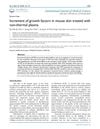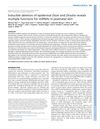Search
forLearn
4 / 4 resultslearn Epidermal Growth Factor
learn Low Level Laser Therapy
laser therapy for anti-inflammatory and likely insignificant hair regrowth effects
learn Osteopontin
signaling protein that, when suppressed, may grow hair by reducing inflammation and stem cell loss
Research
5 / 1000+ resultsresearch Long-Term Expansion and Differentiation of Adult Murine Epidermal Stem Cells in 3D Organoid Cultures
A new 3D culture system helps grow and study mouse skin stem cells for a long time.

research Increment of Growth Factors in Mouse Skin Treated with Non-Thermal Plasma
Non-thermal plasma treatment makes mouse skin thicker and increases growth factors without harming the tissue.

research Inducible Deletion of Epidermal Dicer and Drosha Reveals Multiple Functions for miRNAs in Postnatal Skin
Drosha and Dicer are essential for hair follicle health and preventing DNA damage in skin cells.

research Expansion Culture of Hair Follicle Stem Cells Through Uniform Aggregation in Microwell Array Devices
The new microwell device helps grow more hair stem cells that can regenerate hair.
research Matricellular Proteins in the Homeostasis, Regeneration, and Aging of Skin
Special proteins are important for skin balance, healing, and aging, and affect skin stem cells.
Community Join
5 / 82 resultscommunity The Real Cause Of Androgenetic Alopecia
Androgenetic alopecia is caused by DHT affecting hair growth. Finasteride and minoxidil are used to manage hair loss by blocking DHT and promoting hair growth.

community Compressed part of research of theory of androgenic/anabolitic balance. AGA h-responders analytic. Theory of physio-metabolitic method of anti AGA treatment
The treatment for androgenetic alopecia involves using finasteride and minoxidil with intense exercise and cold exposure to boost metabolism and reduce androgenic effects, potentially leading to hair regrowth. This approach may activate biological pathways for improved hair and overall health.

community If You Have DUPA, PLEASE READ THIS: Everyone Should Be Scalp Biopsied
Scalp biopsies are crucial for diagnosing hair loss conditions like Diffuse Unpatterned Alopecia (DUPA) and retrograde hair loss, as treatments like finasteride and dutasteride may not be effective if other conditions are present. Combining PPAR-GAMMA agonists with retinoids could improve treatments for conditions like Lichen Planopilaris.
community Microneedling at .25 everyday before applying Min
Daily microneedling at 0.25mm before applying minoxidil is debated, with some suggesting weekly microneedling is safer and more effective. Concerns include potential skin damage and systemic absorption, while alternatives like tretinoin are considered safer for enhancing minoxidil absorption.
community The Fear of Oral Minoxidil is Overblown
Low-dose oral minoxidil is a safe and effective hair loss treatment with fewer side effects than previously feared. Users often prefer it over topical minoxidil for better results, though some experience side effects like increased body hair and cardiovascular issues.